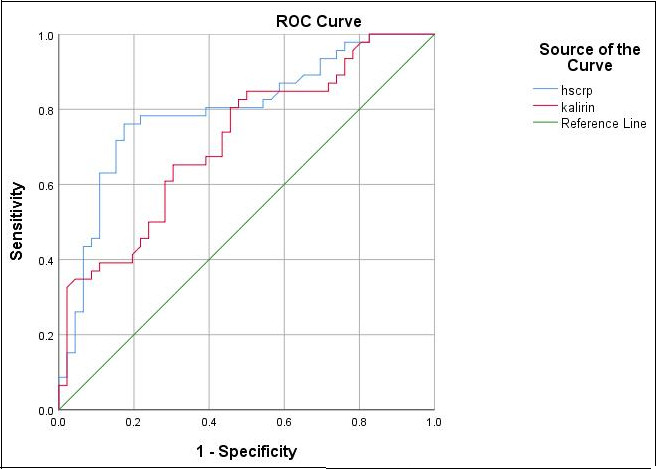Association of hsCRP and Serum Kalirin Levels with the Development and Severity of Premature Coronary Artery Disease in Iraqi Patients
DOI:
https://doi.org/10.54133/ajms.v7i1.1272Keywords:
Coronary artery disease, hsCRP, Kalirin, Premature coronary artery diseaseAbstract
Background: Coronary artery disease (CAD) is a major contributor to morbidity and mortality worldwide. Early-onset CAD, also known as PCAD, is a severe form of CAD associated with high mortality and a poor prognosis. Early diagnosis is crucial to reducing complications. While hsCRP is an established biomarker for CAD, kalirin is a potential novel biomarker due to its role in promoting smooth muscle proliferation and endothelial dysfunction. Objective: To evaluate the relationship between serum kalirin and hsCRP levels with the presence and severity of PCAD and to compare the diagnostic value of both biomarkers. Method: The study recruited 92 participants into two groups: the PCAD group (46) included patients with confirmed CAD by angiographic findings and the second group was the non-CAD group (46) with negative findings by coronary angiography. The levels of serum kalirin and hsCRP were measured for both groups using enzyme-linked immunosorbent assay (ELISA) kits. Results: Serum levels of kalirin and hsCRP were strongly associated with the presence of PCAD (p<0.001), and both biomarkers were associated with disease severity (p=0.002, <0.001, respectively). ROC analysis showed that hsCRP possesses a slight advantage (AUC=0.796) over kalirin (ROC=0.717) as a diagnostic marker for PCAD. Conclusions: Serum kalirin and hsCRP levels are associated with PCAD and with the severity of the disease, both markers possess moderate diagnostic capabilities for PCAD with a slight advantage for hsCRP.
Downloads
References
Malakar AK, Choudhury D, Halder B, Paul P, Uddin A, Chakraborty S. A review on coronary artery disease, its risk factors, and therapeutics. J Cell Physiol. 2019;234(10):16812-16823. doi: 10.1002/jcp.28350.
Benjamin EJ, Blaha MJ, Chiuve SE, Cushman M, Das SR, Deo R, et al. Heart disease and stroke statistics-2017 update: A Report From the American Heart Association. Circulation. 2017;135(10):e146-e603. doi: 10.1161/CIR.0000000000000485.
Abd RK, Abd SN, Raman V. Tracing the risk factors of heart diseases at Al-Nasiriyah heart center in Iraq. J Cardiovasc Disease Res. 2019;10(1):31-34. doi : 10.5530/jcdr.2019.1.6.
Sharma SK, Makkar JS, Bana A, Sharma K, Kasliwal A, Sidana SK, et al. Premature coronary artery disease, risk factors, clinical presentation, angiography and interventions: Hospital based registry. Indian Heart J. 2022;74(5):391-397. doi: 10.1016/j.ihj.2022.08.003.
Collet JP, Zeitouni M, Procopi N, Hulot JS, Silvain J, Kerneis M, et al. Long-term evolution of premature coronary artery disease. J Am Coll Cardiol. 2019;74(15):1868-1878. doi: 10.1016/j.jacc.2019.08.1002.
Zeitouni M, Clare RM, Chiswell K, Abdulrahim J, Shah N, Pagidipati NP, et al. Risk factor burden and long-term prognosis of patients with premature coronary artery disease. J Am Heart Assoc. 2020;9(24):e017712. doi: 10.1161/JAHA.120.017712.
Poorzand H, Tsarouhas K, Hozhabrossadati SA, Khorrampazhouh N, Bondarsahebi Y, Bacopoulou F, et al. Risk factors of premature coronary artery disease in Iran: A systematic review and meta-analysis. Eur J Clin Invest. 2019;49(7):e13124. doi: 10.1111/eci.13124.
Rasheed MK, Rasheed MK, Halla G. Interleukin-6 and high-sensitivity C-reactive protein correlation in atherosclerosis in Iraqi type 2 diabetic patients. J Den Med Sci. 2013;10(6):66-73.
Hussein WK, Al-Bayatti AA, Salman EN. High sensitivity C-reactive protein is a significant predictor for hypertension and obesity in Iraqi postmenopausal women. J Fac Med Baghdad. 2009;51(3):328-331.
Khazaal FAK, Fadhil SH. Assessment of high sensitivity C. reactive protein in male patients with metabolic syndrome and atherosclerosis complications. AL-Kindy Coll Med J. 2012;8(2):12-17.
Ibrahim AE, EL-Yassin HD, AL-Janabi HKS. The impact of inflammation on Resistin, IL-6 and CRP in Acute Myocardial Infarction Patients. J Fac Med Baghdad. 2011;53(2):216-220.
AbdulKarim NG, Taher MA, Almarayati AN. The role of some inflammatory markers (IL-6 and CRP) in the pathogenesis of acute coronary syndrome in Iraqi CCU for Heart Diseases. Iraqi J Pharm Sci. 2011;20(1):43-94.
Khera AV, Kathiresan S. Genetics of coronary artery disease: discovery, biology and clinical translation. Nat Rev Genet. 2017;18(6):331-344. doi: 10.1038/nrg.2016.160.
Wang L, Hauser ER, Shah SH, Pericak-Vance MA, Haynes C, Crosslin D, et al. Peakwide mapping on chromosome 3q13 identifies the kalirin gene as a novel candidate gene for coronary artery disease. Am J Hum Genet. 2007;80(4):650-663.
Wu JH, Fanaroff AC, Sharma KC, Smith LS, Brian L, Eipper BA, et al. Kalirin promotes neointimal hyperplasia by activating Rac in smooth muscle cells. Arterioscler Thromb Vasc Biol. 2013;33(4):702-708. doi: 10.1161/ATVBAHA.112.300234.
Parnell E, Shapiro LP, Voorn RA, Forrest MP, Jalloul HA, Loizzo DD, et al. KALRN: A central regulator of synaptic function and synaptopathies. Gene. 2021;768:145306. doi: 10.1016/j.gene.2020.145306.
Shafiei A, Pilehvar-Soltanahmadi Y, Ziaee S, Mofarrah M, Zarghami N. Association between Serum Kalirin Levels and the KALRN gene rs9289231 polymorphism in early-onset coronary artery disease. J Tehran Univ Heart Center. 2018;13(2):58.
Habib SS, A AAM. Relationship of high sensitivity C-reactive protein with presence and severity of coronary artery disease. Pak J Med Sci. 2013;29(6):1425-1429. doi: 10.12669/pjms.296.3302.
Members WC, Gulati M, Levy PD, Mukherjee D, Amsterdam E, Bhatt DL, et al. 2021 AHA/ACC/ASE/CHEST/SAEM/SCCT/SCMR guideline for the evaluation and diagnosis of chest pain: a report of the American College of Cardiology/American Heart Association Joint Committee on Clinical Practice Guidelines. J Am Coll Cardiol. 2021;78(22):e187-e285. doi: 10.1161/CIR.0000000000001029.
Virani SS, Newby LK, Arnold SV, Bittner V, Brewer LC, Demeter SH, et al. 2023 AHA/ACC/ACCP/ASPC/NLA/PCNA Guideline for the Management of Patients With Chronic Coronary Disease: A Report of the American Heart Association/American College of Cardiology Joint Committee on Clinical Practice Guidelines. J Am Coll Cardiol. 2023;82(9):833-955. doi: 10.1016/j.jacc.2023.04.003.
Baral P, Shrestha R, Shrestha RN, Banstola D, Prajapati R. A study of height, weight and body mass index in Nepalese. J Gandaki Med Coll Nepal. 2021;14(2):88-92.
Kumar V, Gill KD, Kumar V, Gill KD, (Eds.),To Perform Enzyme-Linked Immunosorbent Assay. Springer; 2018.
Human Kalirin, KALRN ELISA Kit - BT LAB. Available at: https://www.bt-laboratory.com/index.php/Shop/Index/productShijiheDetail/p_id/812.html (Accessed 2024).
Human High Sensitivity C-Reactive Protein ELISA KIT - BT LAB. Available at: https://www.listarfish.it/product_files/10602/high-sensitivity-c-reactive-proteinhs-crpelisa-kit.pdf (Accessed 2024).
Bunker GK, Patidar M, Atal D, Meena RL. Evaluation of risk factors of premature coronary artery disease in patients from north India: A rising epidemic. Indian J Clin Cardiol. 2022;3(4):183-187. doi: 10.1177/26324636221123366.
Morovatdar N, Bondarsahebi Y, Khorrampazhouh N, Hozhabrossadati SA, Tsarouhas K, Rezaee R, et al. Risk factor patterns for premature versus late-onset coronary artery disease in Iran: A systematic review and meta-analysis. Open Cardiovasc Med J. 2019;13(1). doi: 10.2174/1874192401913010005.
Wang H, Liu Z, Shao J, Jiang M, Lu X, Lin L, et al. Pathogenesis of premature coronary artery disease: Focus on risk factors and genetic variants. Genes Dis. 2022;9(2):370-380. doi: 10.1016/j.gendis.2020.11.003.
Al-Mashhadani Z, Aboddy AA, Alhamdy RA, Aljawari AY, Aljawari HY. Evaluation of Incidence, Causes, and Management of Hypertension among a Sample of Iraqi Young People. Int J Pharm Res. 2021;13(1). 10.31838/ijpr/2021.13.01.372.
Li H, Yu S, Wang R, Sun Z, Zhou X, Zheng L, et al. Genetic variant of Kalirin gene is associated with ischemic stroke in a Chinese Han population. Biomed Res Int. 2017;2017:6594271. doi: 10.1155/2017/6594271.
Dang M, Wang Z, Zhang R, Li X, Peng Y, Han X, et al. KALRN rare and common variants and susceptibility to ischemic stroke in Chinese Han population. Neuromolecular Med. 2015;17(3):241-250. doi: 10.1007/s12017-015-8352-z.
Dang M, Song Y, Li Q, Zhang C, Peng Y, Wei Z, et al. Genetic variation of the kalirin gene is associated with ICAS in the Chinese population. J Mol Neurosci. 2018;66:157-162. doi: 10.1007/s12031-018-1130-2.
Boroumand M, Ziaee S, Zarghami N, Anvari MS, Cheraghi S, Abbasi SH, et al. The Kalirin gene rs9289231 polymorphism as a novel predisposing marker for coronary artery disease. Lab Med. 2014;45(4):302-308. doi: 10.1309/LMLS813ZDPHRFLUU.
Al-Karkhi IH, Ibrahim AE, Yaseen AK. Levels of insulin, IL-6 and CRP in patients with unstable angina. Adv Clin Exp Med. 2013;22(5):655-658. PMID: 24285449.
Al-Obaidi AZ, Al-Saffar JM. Serum level of interleukin-33, C-reactive protein, and troponin in Iraqi coronary artery disease patients. Iraqi J Sci. 2020:314-321. doi: 10.24996/ijs.2020.61.2.8.
Hassan AJ. Relations of high sensitive C-reactive protein (hs-CRP) with microalbuminuria as a useful predictor of cardiovascular risk among type 1 diabetes mellitus patients. J Fac Med Baghdad. 2016;58(1):90-93.
Tajfard M, Tavakoly Sany SB, Avan A, Latiff LA, Rahimi HR, et al. Relationship between serum high sensitivity C-reactive protein with angiographic severity of coronary artery disease and traditional cardiovascular risk factors. J Cell Physiol. 2019;234(7):10289-10299. doi: 10.1002/jcp.27945.
Memon L, Spasojevic-Kalimanovska V, Bogavac-Stanojevic N, Kalimanovska-Ostric D, Jelic-Ivanovic Z, Spasic S, et al. Association of C-reactive protein with the presence and extent of angiographically verified coronary artery disease. Tohoku J Exp Med. 2006;209(3):197-206. doi: 10.1620/tjem.209.197.
Kamath DY, Xavier D, Sigamani A, Pais P. High sensitivity C-reactive protein (hsCRP) & cardiovascular disease: An Indian perspective. Indian J Med Res. 2015;142(3):261-268. doi: 10.4103/0971-5916.166582.
Al-Tu’maa FJ, Abd-Yasera Z, Al-Naffi KO. Association between hs-CRP levels and the severity of coronary atherosclerosis. J Contemp Med Sci. 2016;2(6):42-44.
Habib SS. Level of high-sensitivity C-reactive protein in Saudi patients with chronic stable coronary artery disease. J Ayub Med Coll Abbottabad. 2008;20(2):3-6.
Warka’a T, Jasim HS. Hs-CRP and haptoglobin levels in Iraqi patients with coronary artery disease. J Fac Med Baghdad. 2015;57(1):84-86. doi: 10.32007/jfacmedbagdad.571318.

Downloads
Published
How to Cite
Issue
Section
License
Copyright (c) 2024 Al-Rafidain Journal of Medical Sciences ( ISSN 2789-3219 )

This work is licensed under a Creative Commons Attribution-NonCommercial-ShareAlike 4.0 International License.
Published by Al-Rafidain University College. This is an open access journal issued under the CC BY-NC-SA 4.0 license (https://creativecommons.org/licenses/by-nc-sa/4.0/).











